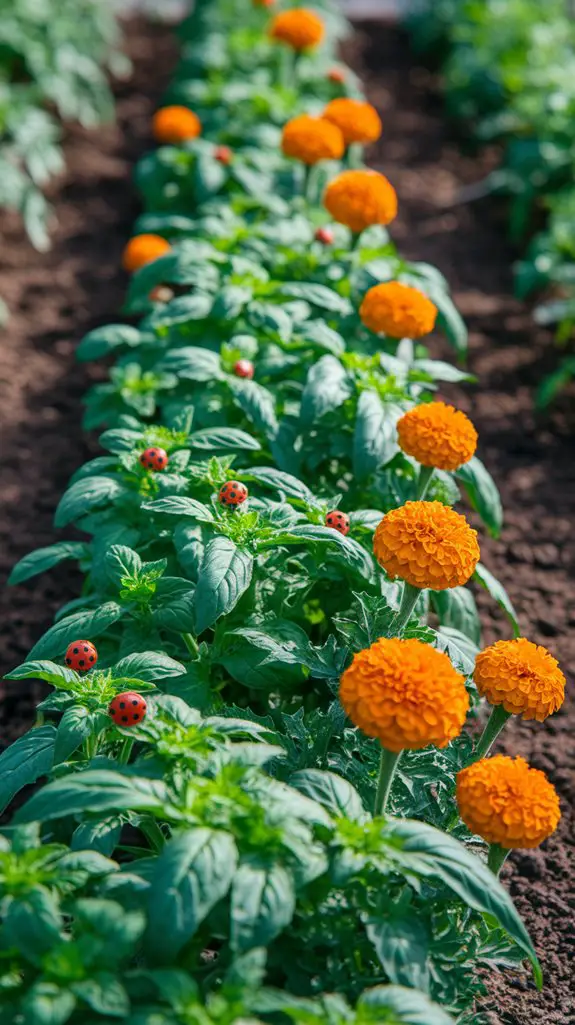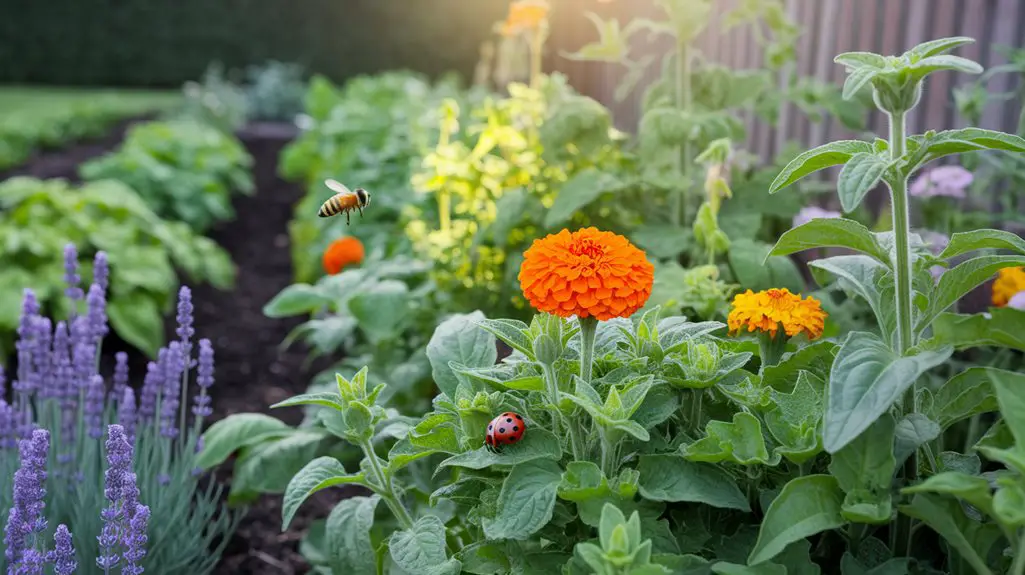Could organic methods truly match synthetic pesticides for effectiveness in your backyard garden? You don’t need harsh chemicals to keep pests at bay while growing healthy produce. By combining companion planting, natural repellents, and soil-building practices, you’ll create a balanced ecosystem where beneficial insects thrive and harmful ones struggle. These interconnected strategies work in harmony with nature rather than against it—and your vegetables, flowers, and herbs will show the difference.
Understanding Common Garden Pests and Their Impact
Before implementing any organic pest control strategies, you’ll need to identify the common culprits threatening your garden’s health.
Aphids, caterpillars, slugs, and beetles comprise the primary offenders in most gardens, each causing distinct damage patterns.
Aphids suck plant sap, resulting in curled leaves and stunted growth, while caterpillars chew irregular holes in foliage.
Slugs leave slime trails and ragged edges on leaves, targeting seedlings and tender plants. Ground-dwelling beetles damage roots, while Japanese beetles skeletonize leaves.
The impact extends beyond visible damage—pests can transmit diseases, reduce yields, and weaken plants’ overall resilience.
By learning to recognize specific pest signatures—leaf discoloration, wilting, holes, or distorted growth—you’ll intervene before infestations become severe.
Remember that some insects are beneficial predators that help maintain your garden’s ecological balance. Effective natural pest control methods can also enhance the health of your flower garden while minimizing chemical use.
The Benefits of Choosing Organic Pest Control Methods

Choosing organic pest control methods offers multiple advantages that extend far beyond your garden’s boundaries. You’ll protect beneficial organisms like pollinators and predatory insects that maintain your garden’s ecological balance while avoiding chemical resistance issues that synthetic pesticides often create.
| Benefits | Impact |
|---|---|
| Environmental | Prevents soil & water contamination |
| Health | Eliminates toxic residue on produce |
| Ecosystem | Preserves beneficial insect populations |
When you opt for organic approaches, you’re investing in sustainable gardening that supports biodiversity and improves soil health over time. Your plants develop natural resilience against pests, reducing the need for continuous intervention. You’ll also safeguard your family’s health by avoiding exposure to harmful chemical compounds that can accumulate in the environment and food chain. Additionally, incorporating certain essential plants can further enhance your organic pest control efforts.
Companion Planting Strategies to Deter Harmful Insects

Companion planting, one of nature’s most elegant defense systems, strategically positions certain plant species together to naturally repel destructive pests.
You’ll find marigolds particularly effective at deterring nematodes and aphids when planted alongside tomatoes. Plant nasturtiums as sacrifice plants to draw aphids away from your prized vegetables.
For your cabbage family crops, intersperse aromatic herbs like thyme, sage, and rosemary to confuse cabbage moths and other brassica pests.
Garlic and onions make excellent companions for roses, as they repel aphids and black spot.
Consider the “three sisters” method—corn, beans, and squash—which creates a natural ecosystem where these plants protect each other while maximizing growing space. Additionally, these companion plantings can enhance natural pest control by promoting biodiversity and attracting beneficial insects.
These pairings don’t just deter pests; they often improve growth, flavor, and yield.
Homemade Natural Sprays and Repellents
While companion planting offers preventative protection, homemade sprays and repellents provide direct intervention when pests have already arrived in your garden. You can create effective solutions using common household ingredients that won’t compromise your organic standards.
Mix one tablespoon of liquid soap with one quart of water to target aphids and mites. For fungal issues, combine one tablespoon of baking soda with a gallon of water and a drop of dish soap.
Garlic-pepper spray—made by steeping crushed garlic and hot peppers in water overnight—deters numerous pests through its powerful compounds. Natural pest management techniques like these are essential for maintaining a healthy garden ecosystem.
Always test sprays on a small leaf area first to check for plant sensitivity. Apply in early morning or evening to prevent leaf burn and maximize effectiveness. Reapply after rain or heavy dew for continuous protection.
Beneficial Insects: Your Garden’s Natural Defenders
Three key insect groups serve as your garden’s natural defense force against destructive pests. Ladybugs, lacewings, and parasitic wasps work tirelessly to keep pest populations in check, eliminating the need for harsh chemical controls.
You’ll find these beneficial insects most effective when you create a welcoming environment with diverse plantings and minimal pesticide use. Even organic sprays can harm these helpers, so apply any treatments selectively. Additionally, promoting natural pest solutions in your garden can enhance the effectiveness of these beneficial insects.
| Beneficial Insect | Target Pests | How to Attract |
|---|---|---|
| Ladybugs | Aphids, mites | Plant dill, fennel, yarrow |
| Lacewings | Aphids, thrips, mealybugs | Provide shallow water sources |
| Parasitic Wasps | Caterpillars, beetle larvae | Grow flowering herbs, alyssum |
Integrate these natural predators into your garden ecosystem, and you’ll establish a sustainable pest management system that requires minimal intervention.
Physical Barriers and Traps for Pest Management
When dealing with persistent garden pests, physical barriers and traps offer effective, non-toxic solutions that complement biological controls.
Row covers, nets, and cardboard collars prevent insects from reaching plants while still allowing water and sunlight through. Install floating row covers to block flying insects like cabbage moths, and copper tape to deter slugs.
Strategic trapping can reduce pest populations considerably. Yellow sticky traps attract whiteflies and aphids, while beer traps sink slugs.
For larger pests, consider physical exclusion—hardware cloth protects root vegetables from voles, while fencing keeps rabbits at bay. Effective DIY traps can be easily created using household materials to enhance your pest management efforts.
You’ll get best results by combining multiple barrier types. Remember to secure edges properly and monitor regularly for tears or breaches.
Rotate portable barriers between crop families to prevent soil-borne diseases from building up beneath them.
Crop Rotation and Diversity to Prevent Infestations
Because persistent pests often develop targeted feeding patterns, strategic crop rotation serves as one of your most powerful preventative controls in organic gardening. By changing what you plant in each bed annually, you’ll disrupt pest life cycles that depend on specific host plants.
Don’t grow related crops in the same location for at least three years.
Embrace diversity beyond rotation. Interplanting compatible crops creates beneficial relationships—tall corn can shade heat-sensitive lettuce while deterring pests that target it.
Incorporate flowering companion plants like marigolds, nasturtiums, and sweet alyssum to attract beneficial insects that prey on garden pests. This practice not only bolsters pest control but also supports biodiversity in ecosystems, which is crucial for maintaining a balanced environment.
You’ll find that polyculture (diverse plantings) greatly outperforms monoculture in pest resistance while improving soil health and biodiversity.
This approach mimics natural ecosystems where pests rarely achieve devastating population levels.
Soil Health and Its Role in Pest Resistance
Healthy soil forms the foundation of pest-resistant gardens, acting as your first line of defense against harmful insects and diseases. When you build soil rich in organic matter and teeming with beneficial microorganisms, you’re creating an environment where plants can develop natural resistance to pests.
Focus on maintaining proper pH levels (typically 6.0-7.0) and incorporate compost regularly to boost microbial diversity. These microbes help break down nutrients into forms plants can readily absorb, strengthening their immune systems.
Well-nourished plants produce stronger cell walls and natural compounds that deter pests.
Don’t overlook the value of proper drainage and soil structure. Compacted soil stresses plants, making them vulnerable to attacks.
Use mulch to regulate soil temperature and moisture—two critical factors in maintaining soil biology that supports your garden’s natural defense mechanisms.
Timing Your Plantings to Avoid Peak Pest Seasons
Timing your garden plantings strategically offers another powerful layer of organic pest management beyond soil preparation. By understanding pest life cycles, you’ll create a temporal barrier against infestations.
Plant cool-season crops like peas and spinach early in spring before aphids proliferate. Delay susceptible vegetables such as squash until cucumber beetles have completed their first generation. For tomatoes, wait until soil temperatures reach 60°F to avoid fungal issues that thrive in cool, damp conditions.
In warmer regions, utilize fall planting windows when pest populations naturally decline. Consider succession planting to guarantee some crops escape peak pest pressure.
Monitor local pest forecasts and phenological indicators—like when certain wildflowers bloom—to fine-tune your planting schedule. This timing-based approach reduces the need for interventions later in the growing season. Additionally, incorporating non-toxic pest control techniques can further enhance your garden’s resilience against unwanted infestations.
Maintaining a Balanced Ecosystem in Your Garden
A thriving garden ecosystem serves as your greatest ally in organic pest control, creating a self-regulating environment where beneficial organisms keep potential pests in check.
Diversify your plant selection to include flowers that attract predatory insects like ladybugs, lacewings, and parasitic wasps, which feed on common garden pests.
Add habitat features such as stone piles, bird baths, and insect hotels to support beneficial wildlife.
Avoid broad-spectrum pesticides that kill indiscriminately, disrupting this delicate balance.
Instead, practice soil-building techniques through regular addition of compost, which fosters microorganisms that improve plant health and resilience.
In addition, creating a habitat for beneficial insects can significantly enhance their populations and effectiveness in pest control.
Conclusion
By integrating these organic pest control strategies, you’ll create a resilient garden ecosystem that manages pests naturally. The Peterson family in Oregon eliminated their aphid problem completely by introducing ladybugs and planting marigold borders, while their neighbors continued struggling with chemical sprays. Remember: effective organic pest management isn’t about eliminating all insects—it’s about fostering balance that allows your plants to thrive without synthetic interventions.




